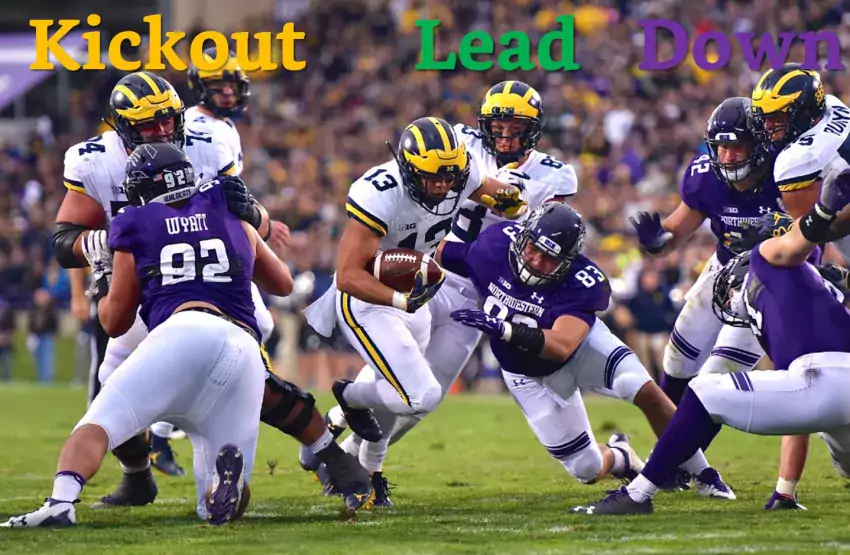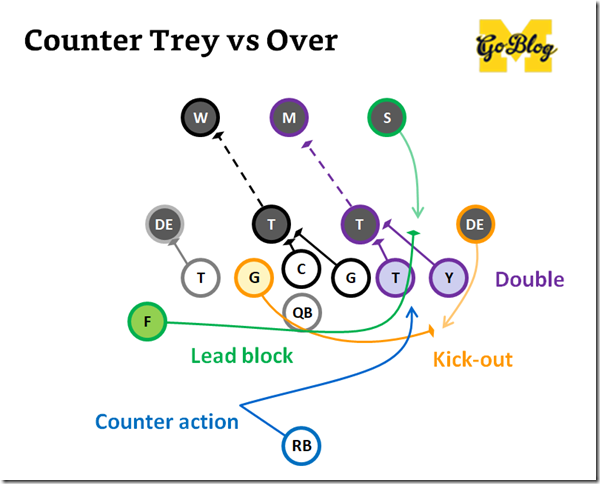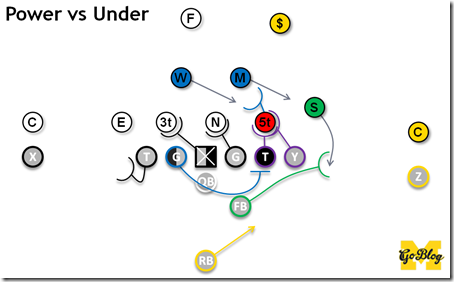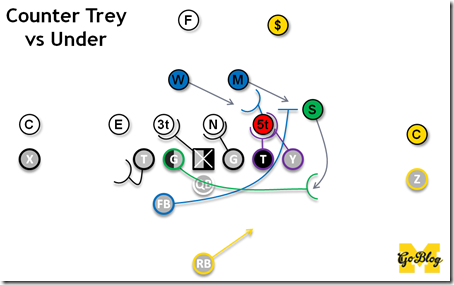power

This series is a work-in-progress glossary of football concepts we tend to talk about in these pages. Previously:
Offensive concepts: RPOs, high-low, snag, mesh, covered/ineligible receivers, Duo, zone vs gap blocking, zone stretch, split zone, pin and pull, inverted veer, reach block, kickout block, wham block, Y banana play, TRAIN, the run & shoot
Defensive concepts: The 3-3-5, Contain & lane integrity, force player, hybrid space player, no YOU’RE a 3-4!, scrape exchange, Tampa 2, Saban-style pattern-matching, match quarters, Dantonio’s quarters, Don Brown’s 4-DL packages and 3-DL packages, Bear
Special Teams: Spread punt vs NFL-style
So counter trey and its counter, BASH, are a pair of offensive concepts we're going to see more of, possibly from and certainly against Michigan. While things like it were part of the Single Wing offenses of the early 20th century, Tom Osborne's Nebraska teams really made Counter Trey a staple of power running. Michigan ran a bunch of counter under Drevno, and while they moved away from it last year, it has come up often lately in opponent scouting, most prominently in the Maryland offense when Mike Locksley was the OC. Since Locksley is now their HC, and because I know Gattis saw it plenty under Locksley last year, and Ohio State was doing it a bunch last year, I figured it would be a good time to cover these concepts so you can ID them when they come, starting with the ol' favorite, Counter Trey.
THE CONCEPT:
Counter Trey is a slow-developing counter run where you block down on the playside tackle and pull multiple guys from the backside for the two crucial frontside defenders: a guard to kick out an unblocked edge defender, and another guy from the backside (usually a TE or a tackle) to lead block into the frontside linebacker, with the back cutting off that block in the hole.
The plan here is to 1) Block down on the playside tackle, doubling to the MIKE, thus setting the inside wall of the gap. 2) Kick out the playside DE with the backside pulling guard to pry open the other side of the gap, 3) Bring a second puller (backside TE or OT) as lead blocker through the gap to take out the playside LB, and 4) Have the running back take a false step to freeze defenders to the backside, then cut behind the second puller and follow into the gap.
This definition gets controversial because it has expanded over the years. Voters in my informal twitter poll were split evenly between the definition above and any play with counter action and a puller, with a pedantic handful who stick to Osborne's original terminology. For our purposes I use the definition by Ross Fulton…
Anything that trades the responsibilities of power, such that the backside guard is kicking out and the backside T or Y-off is leading
— Ross Fulton (@RossRFulton) July 26, 2019
…plus counter action.
"Counter" in this sense refers to the initial motion of the back(s)—the running back will start the play with a short step counter to the flow of the play, serving as a fakeout to freeze any linebackers reading backfield motion, plus something to do in that second while the blocking is getting set up. "Trey" came out of Osborne's terminology for combination blocks: "Trey" meant a tackle+TE double-team. "Deuce" was a guard+tackle, and "Ace" was center+guard combo. I'm sure you can dig up a coach who swears a T/G double-team is "Counter Deuce" but to most "Trey" means backside guard->kickout+backside lead puller, kind of like how "secondary" has lost its meaning as "second level of defense" and become synonymous with defensive backs. As you can see in the drawing above, Osborne's terms made sense in a world full of fullbacks and tight ends. As we're about to find, this concept is so adaptable that you see it all the time today with no such things.
[After THE JUMP: How to spot it, how to defend it, what they do with it]
THIS ARTICLE HAS A SPONSOR: If you’re at that point where you’re thinking further out than the Maryland game it’s time to start a conversation with Nick Hopwood, our MGoFinancial Planner from Peak Wealth Management.  This conversation doesn’t have to be about your financial future and security; he’s also willing to discuss power/counter run game futures.
This conversation doesn’t have to be about your financial future and security; he’s also willing to discuss power/counter run game futures.
Our deal is Nick is the guy I go to for financial strategies, and he gets to ask us Michigan questions on your behalf. Anytime it’s a Nick question, we’ll let you know. Anytime you’ve got a financial question, let Nick know.
-------------------------------
Legal disclosure in tiny font: Calling Nick our official financial planner is not intended as financial advice; Nick is an advertiser who financially supports MGoBlog. MGoBlog is not responsible for any advice or other communication provided to an investor by any financial advisor, and makes no representations or warranties as to the suitability of any particular financial advisor and/or investment for a specific investor.
--------------------------------
[Bryan Fuller]
Nick’s Question:
How sustainable is the run game?
The Mathlete: My first thought is who else is running the ball like Michigan has lately and how have they fared against the best defenses. Because that is really the question. There is little doubt that the run game will be sustainable against Maryland. Wisconsin and Ohio State are different questions. So far this year Michigan has 3 games of 200 yards and 6 YPC with sacks and garbage time excluded against Power 5 opponents. Five other teams can say that. Arizona, Notre Dame and Louisville have elite running QBs and aren't really considerations. Oregon and Oklahoma both utilize the QB in running game effectively, so maybe not them. Right there, Michigan is doing something that isn't easy to do without a QB involved running game.
Last year Georgia and Stanford each accomplished the threshold four times and are probably our best comparisons. Against playoff bound Washington, Stanford was completely shut down for <1 yard a carry and McCaffrey didn't crack 50 yards for the day. Georgia barely cracked 1 yard a carry against Florida and survived against Auburn with 3.1 YPC.
This isn't by any means an exhaustive or complete list, but the road is uphill for a rushing attack without a quarterback run threat against top level defenses. (edited)
[Hit THE JUMP for the rest of the responses]
Things that happen against Rutgers’s defense can’t be taken too seriously. They’re playing a former Brady Hoke cornerback as a SAM in a 4-3 under, which means he’s taking on fullbacks and pulling guards. Their other edge guy is Kemoko Turay, an athletic dude who’s still rather unfamiliar with the game of football, and who’s functioning now as a WDE/OLB hybrid. Their WLB is by some distance the worst player I’ve scouted this year. One of their safeties is 5’9” and was their leading receiver last year and just joined the defense three weeks ago. The other safety is worse.
But their three interior DL are pretty stout. This made the Rutgers game uniquely suited to Michigan’s power running game. You know Power, Michigan’s base play under Jim Harbaugh, Brady Hoke, Lloyd Carr, and Fielding H. Yost. God’s play. Power.
Power and its close cousin Counter Trey are a lot like Inside Zone in that as a base play there are a ton of ways to run it depending on what the defense is showing and who appears where.
The concept is simple enough: 1) Block down on as many line defenders as you can to seal them inside, 2) Pry open a gap between them and the playside edge protector, and 3) Swing around a backside blocker into the point of attack to hit the first guy he sees. Win those downblocks and kick out the edge and now it’s just a race to see if your meat and the ball can get through that gap before the defense can plug it.
On “Power” the swing man is usually your backside guard, while a fullback or H-back is the “trapper” or pry-bar trying to blow the edge open. On “Counter Trey” those guys swap jobs. Note the backfield action is like a run to the right side, and that the pulling guard is wiping out the edge:
Counter Trey. (The guy Ben Mason blocked into the endzone is an awful, awful player, but still: braaaaawwwwrrrr!)
[Hit THE JUMP for what Rutgers did, and how Michigan didn’t have to respond because an answer was built into the play did I tell you this is God’s play?]
-------------------------------------




19